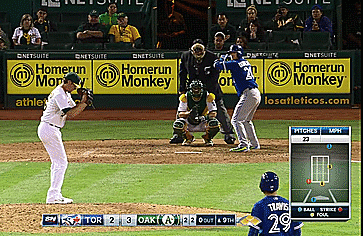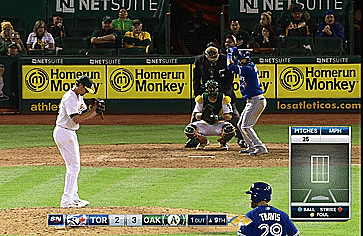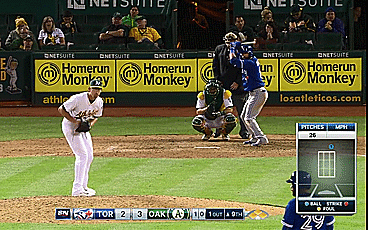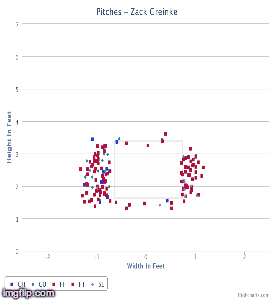Contact quality is a recurring sabermetric theme. Much discussion over the last decade has centered around how we interpret Voros McCracken’s groundbreaking analysis, where he showed that the majority of variance in a pitcher’s ERA was driven by the rates at which he recorded strikeouts, walks, and home runs allowed. This led to the conclusion by many that the batting average on balls in play (excluding homers) was largely outside of a pitcher’s control, and further research has probed the influence of team defense, home ballpark, and other outside factors on differences in BABIP.
Nevertheless, pitchers like Dallas Keuchel and Chris Young seem to have above-average success in “pitching to contact”, even after allowing for outside factors. To better understand such outliers from the standard fielding-independent pitching model, I have developed a new bottom-up framework to analyze the quality of contact allowed, using the newly-available batted-ball data from MLB Advanced Media (via Baseball Savant). This model takes all batted balls (including homers) and calculates the expected run value based upon how hard the ball was hit (“exit velocity”) and the estimated angle at which it left the bat (“vertical angle”). In addition to the contact quality model, I’ve also developed a parallel model to estimate the defense-independent expected run value from batted-ball data (yes, contact quality and defense-independent run value are two different things.)
Relationship to FIP
The key difference between the Comprehensive Contact Quality Model and FIP is the integration of expected home runs allowed into the analysis. Various metrics such as xFIP have attempted to account for the volatility in HR% by normalizing this rate as a fixed percentage of fly balls allowed. A different perspective is to treat home runs as one extreme in a broad spectrum of contact quality:
Swinging strike < Foul tip < Weakly-hit fair ball < Well-hit fair ball
This spectrum ranks how well the hitter has “squared up” on the ball, with better-struck balls further to the right. Home runs can be considered a subset of well-hit fair balls, where the likelihood of actually becoming a four-bagger depends primarily upon the distance travelled, which itself is a function of exit velocity, vertical angle, and a host of other factors. So, when we talk about a pitcher’s ability to limit the long ball, what we’re really talking about is his ability (if any) to prevent the ball from being hit hard at an optimum angle to leave the park.
With that brief introduction, let’s outline the framework for valuing the contact quality on any batted ball. First, for balls hit in the air:
Step 1 – Estimate the Probability of a Home Run
For this first iteration of the model, I made the following simplifying assumptions:
- Exactly 1/30 of all outfield fly balls are hit in each MLB ballpark
- The direction of these balls is distributed 20% LF to LC, 30% LC to CF, 30% CF to RC, and 20% RC to RF
- Outfield dimensions are as currently posted in Wikipedia
Also since distance in the MLBAM data is measured to the assumed landing point, we also need to adjust for the height of the outfield wall. To do this, I used Dr. Alan Nathan’s excellent trajectory calculator to estimate the complete distance traveled by a ball that is W feet above the ground when it passes over the outfield wall, where W is the height of the wall. Note that this distance will be further for line drives than it will be for high flies, so the necessary distance for a home run will depend upon both the listed distance to the wall and the vertical angle of the batted ball.
[Caution – next section is somewhat technical; you can safely skip and not miss the gist of this article]
One problem with the MLBAM data found on Baseball Savant is that batted-ball angles are only available for home runs. For other batted balls, we can use the fact that we have both the batted-ball velocity and distance to back-solve for the vertical angle:
1. Make grid of distance = f(exit vel, angle), using the default settings in Dr. Nathan’s trajectory calculator:
(Key values shown below – columns are vertical angle, rows are exit velocity)
|
0 |
5 |
10 |
15 |
20 |
25 |
30 |
35 |
40 |
50 |
60 |
| 60 |
49 |
79 |
111 |
138 |
159 |
173 |
182 |
186 |
185 |
169 |
137 |
| 65 |
54 |
91 |
129 |
159 |
182 |
198 |
207 |
210 |
208 |
188 |
152 |
| 70 |
60 |
105 |
148 |
182 |
207 |
223 |
232 |
234 |
231 |
208 |
166 |
| 75 |
66 |
120 |
169 |
207 |
233 |
249 |
258 |
259 |
254 |
227 |
180 |
| 80 |
72 |
136 |
192 |
233 |
260 |
276 |
284 |
284 |
277 |
246 |
194 |
| 85 |
79 |
155 |
217 |
260 |
288 |
304 |
311 |
309 |
301 |
265 |
207 |
| 90 |
87 |
175 |
244 |
289 |
317 |
332 |
338 |
334 |
324 |
283 |
220 |
| 95 |
95 |
198 |
272 |
318 |
346 |
361 |
365 |
360 |
347 |
302 |
233 |
| 100 |
105 |
223 |
302 |
349 |
376 |
389 |
392 |
385 |
370 |
320 |
245 |
| 105 |
115 |
249 |
332 |
380 |
406 |
418 |
419 |
410 |
393 |
338 |
256 |
| 110 |
127 |
277 |
363 |
411 |
436 |
446 |
445 |
434 |
415 |
355 |
268 |
| 115 |
141 |
307 |
394 |
442 |
466 |
474 |
471 |
458 |
437 |
371 |
278 |
| 120 |
156 |
338 |
426 |
472 |
495 |
502 |
497 |
482 |
458 |
387 |
288 |
2. Distance peaks at a certain “optimal” vertical angle then decreases. This means that there are 2 possible solutions for the vertical angle when doing a lookup based upon distance and exit velocity. Lacking any other information, I used the batted-ball type recorded by the Baseball Scoresheet stringers to guide which value to use:
LD uses lower of the two angles, PU uses higher of the two, FB uses mean of the two
This becomes our estimate of vertical angle on the batted ball.
[End of technical note]
Now, for each of the 30 MLB ballparks, we can use the combination of distance and vertical angle to estimate the probability of a homer, assuming the pull/center/opposite mix assumed above (note – version 0.0 of this model does not reflect batted ball direction). After averaging across all ballparks, we get a grid of home run probabilities for any outfield fly ball:
|
0 |
5 |
10 |
15 |
20 |
25 |
30 |
35 |
40 |
50 |
60 |
Actual |
| 300 |
0.0% |
0.0% |
0.0% |
0.0% |
0.0% |
0.0% |
0.0% |
0.0% |
0.0% |
0.0% |
0.0% |
0.0% |
| 310 |
0.0% |
0.0% |
0.0% |
0.0% |
0.0% |
0.0% |
0.0% |
0.0% |
0.0% |
0.0% |
0.1% |
0.0% |
| 320 |
0.0% |
0.0% |
0.0% |
0.0% |
0.1% |
0.1% |
0.1% |
0.1% |
0.2% |
0.2% |
0.3% |
0.1% |
| 330 |
0.0% |
0.0% |
0.1% |
0.2% |
0.3% |
0.4% |
0.5% |
0.7% |
1.0% |
1.4% |
1.7% |
0.6% |
| 340 |
0.0% |
0.0% |
0.2% |
0.6% |
1.3% |
2.5% |
3.9% |
5.0% |
6.0% |
7.4% |
8.2% |
1.7% |
| 350 |
0.0% |
0.0% |
0.9% |
4.4% |
8.1% |
11.1% |
13.2% |
14.7% |
15.9% |
17.6% |
18.5% |
3.2% |
| 360 |
0.0% |
0.1% |
6.0% |
13.4% |
18.7% |
22.1% |
24.3% |
25.9% |
27.1% |
28.8% |
29.8% |
11.1% |
| 370 |
0.0% |
0.4% |
15.3% |
24.0% |
30.4% |
34.0% |
36.3% |
38.0% |
39.2% |
41.0% |
42.0% |
15.3% |
| 380 |
0.0% |
2.7% |
25.7% |
36.8% |
43.0% |
46.3% |
48.3% |
49.9% |
51.0% |
52.8% |
53.8% |
29.1% |
| 390 |
0.0% |
10.0% |
36.1% |
50.0% |
55.2% |
58.7% |
61.3% |
63.2% |
64.8% |
67.0% |
68.3% |
40.7% |
| 400 |
0.0% |
19.0% |
47.8% |
63.5% |
70.1% |
74.5% |
77.5% |
79.8% |
81.5% |
84.0% |
85.3% |
54.1% |
| 410 |
0.0% |
28.1% |
61.8% |
80.1% |
86.6% |
90.0% |
91.7% |
92.9% |
93.7% |
94.8% |
95.4% |
76.3% |
| 420 |
0.0% |
37.6% |
78.0% |
92.2% |
95.2% |
96.4% |
97.0% |
97.5% |
97.9% |
98.2% |
98.3% |
90.3% |
| 430 |
0.0% |
50.1% |
88.9% |
96.6% |
97.7% |
98.3% |
98.7% |
98.8% |
98.9% |
99.0% |
99.1% |
94.8% |
| 440 |
0.0% |
64.6% |
93.5% |
98.0% |
99.0% |
99.4% |
99.5% |
99.6% |
99.7% |
99.7% |
99.8% |
96.7% |
Step 2 – Estimate BABIP if Not a Home Run
One big benefit of hitting the ball over the fence is that virtually no chance of making an out. For balls hit in the air to the outfield, however, there typically three guys whose goal it is to catch the ball in order to get the batter out. Now while a little bit of extra loft on a hard-hit OF fly can improve the chance of a dinger, for balls that stay in play the relationship between BABIP and vertical angle is essentially linear (using first-half 2015 data):
BABIP if hit in the air to OF = .9698 – .0256 * MIN(37.5, angle)
We will use this in conjunction with the next step to determine the run value of a non-homer fly/popup/liner.
Step 3 – Estimate Expected Run Value If A Hit (Non-HR)
For balls not caught by the outfielder, the chances for an extra-base hit vary by vertical angle and also increase for higher exit velocities. Regressing the first-half 2015 data (using hits to the outfield only) results in this estimate:
RV if hit to OF = -1.06 + 0.0206*velocity – 0.00006*velocity^2 + 0.0223*angle – 0.000318*angle^2
We can now calculate the contact-quality run value as:
CQRV = (1.38 x HR Probability) + (RV if hit to OF x (1 – HR Probability))
Contact Quality Run Values for Ground Balls
For ground balls, the expected run value increases with increasing exit velocity. We can estimate the CQRV directly from the following regression equation:
CQRV = 0.35-0.0174*velocity+0.00014*velocity^2, if velocity > 65; else CQRV = -0.19
Note that the expected run value is set to -0.19 for velocity less than 65 MPH. This is because the run expectancy actually improves for grounders hit at a very low speed (basically dribblers and slow rollers). Because this is a model of contact quality, we are not going to penalize the pitcher for poor batted-ball luck when the actual quality of contact is low.
This leads us to a discussion of the last key feature of the model….
Contact Quality vs. Expected Batted-Ball Result
The CQ model is designed to produce higher run values for better quality of contact. However, as discussed in Tony Blengino’s enlightening series on batted-ball outcomes, real-life BABIP doesn’t improve continuously with higher batted-ball velocity, but instead actually decreases over the stretch between balls hit relatively shallow and balls hit to the deeper parts of the outfield. The CQ model calculates BABIP as a function of vertical angle in order to avoid rewarding pitchers for the better-struck balls that fall into the “donut hole” near the depths where outfielders normally position themselves.
I chose vertical angle to model BABIP for the CQ framework because of its close relationship to hang time, which in turn is a key component of the likelihood of the outfielder making the putout. In reality, batted-ball location also plays an important role in determining whether a fielder can range into position to catch the ball. To model this more realistic BABIP, I estimated what proportion of balls hit a certain distance would be reachable by one of the three outfielders, given a certain amount of hang time (note – hang time can be estimated by Dr. Nathan’s trajectory calculator based upon exit velocity and vertical angle). For example, an arc 320 feet from home plate is roughly 502 feet long from foul line to foul line. If we assume that each outfielder can cover 52 feet in 3.0 seconds, then we can draw a circle with a 52 foot radius from each fielder’s initial position and estimate the overlap between the arc and these circles to be about 237 feet. So we assign a 47% chance (237 divided by 502) of catching a fly ball hit 320 feet with a 3.0 second hang time. If we increase the hang time to 4.0 seconds, the coverage circles now have an 87 foot radius, and 479 feet of the arc are covered, for a 95% chance of an out.
Here is how the more realistic BABIP varies based upon both batted-ball distance and hang-time. Note the “donut hole” for balls hit around 300 feet with hang times in the neighborhood of 4 seconds.
|
1.0 |
1.5 |
2.0 |
2.5 |
3.0 |
3.5 |
4.0 |
4.5 |
5.0 |
| 200 |
1.000 |
1.000 |
1.000 |
1.000 |
1.000 |
1.000 |
0.711 |
0.400 |
0.005 |
| 210 |
1.000 |
1.000 |
1.000 |
1.000 |
1.000 |
0.925 |
0.589 |
0.318 |
– |
| 220 |
1.000 |
1.000 |
1.000 |
1.000 |
1.000 |
0.761 |
0.523 |
0.217 |
– |
| 230 |
1.000 |
1.000 |
1.000 |
1.000 |
0.889 |
0.666 |
0.485 |
0.161 |
– |
| 240 |
1.000 |
1.000 |
1.000 |
0.960 |
0.772 |
0.618 |
0.353 |
0.136 |
– |
| 250 |
1.000 |
1.000 |
0.971 |
0.828 |
0.696 |
0.528 |
0.254 |
0.061 |
– |
| 260 |
1.000 |
0.932 |
0.857 |
0.757 |
0.646 |
0.403 |
0.180 |
– |
– |
| 270 |
0.919 |
0.863 |
0.802 |
0.717 |
0.555 |
0.314 |
0.120 |
– |
– |
| 280 |
0.886 |
0.838 |
0.783 |
0.678 |
0.468 |
0.258 |
0.073 |
– |
– |
| 290 |
0.884 |
0.834 |
0.762 |
0.598 |
0.419 |
0.217 |
0.035 |
– |
– |
| 300 |
0.918 |
0.823 |
0.721 |
0.579 |
0.413 |
0.218 |
0.038 |
– |
– |
| 310 |
0.956 |
0.853 |
0.741 |
0.588 |
0.414 |
0.211 |
0.020 |
– |
– |
| 320 |
0.941 |
0.916 |
0.857 |
0.663 |
0.470 |
0.263 |
0.059 |
– |
– |
| 330 |
0.943 |
0.919 |
0.891 |
0.807 |
0.556 |
0.330 |
0.104 |
– |
– |
| 340 |
0.962 |
0.936 |
0.908 |
0.869 |
0.714 |
0.444 |
0.205 |
0.029 |
– |
| 350 |
1.000 |
0.967 |
0.931 |
0.883 |
0.830 |
0.576 |
0.315 |
0.118 |
– |
| 360 |
1.000 |
1.000 |
0.985 |
0.911 |
0.843 |
0.726 |
0.434 |
0.212 |
0.043 |
| 370 |
1.000 |
1.000 |
1.000 |
0.977 |
0.870 |
0.783 |
0.559 |
0.317 |
0.144 |
| 380 |
1.000 |
1.000 |
1.000 |
1.000 |
0.933 |
0.799 |
0.691 |
0.428 |
0.248 |
| 390 |
1.000 |
1.000 |
1.000 |
1.000 |
1.000 |
0.856 |
0.712 |
0.525 |
0.339 |
| 400 |
1.000 |
1.000 |
1.000 |
1.000 |
1.000 |
0.956 |
0.759 |
0.603 |
0.420 |
| 410 |
1.000 |
1.000 |
1.000 |
1.000 |
1.000 |
1.000 |
0.866 |
0.716 |
0.487 |
| 420 |
1.000 |
1.000 |
1.000 |
1.000 |
1.000 |
1.000 |
1.000 |
0.749 |
0.574 |
| 430 |
1.000 |
1.000 |
1.000 |
1.000 |
1.000 |
1.000 |
1.000 |
0.827 |
0.637 |
| 440 |
1.000 |
1.000 |
1.000 |
1.000 |
1.000 |
1.000 |
1.000 |
0.944 |
0.704 |
This neatly explains why fly balls hit at 85 MPH often result in an out, while line drives hit that hard are most often base hits.
| Angle |
0 |
5 |
10 |
15 |
20 |
25 |
30 |
| Distance |
79 |
155 |
217 |
260 |
288 |
304 |
311 |
| Hang Time |
0.7 |
1.4 |
2.2 |
2.9 |
3.5 |
4.1 |
4.5 |
| BABIP |
|
|
1.000 |
0.669 |
0.229 |
0.032 |
– |
If we substitute the hang-time based BABIP for the vertical-angle based BABIP used in the CQ model, we obtain a batted-ball-data expected run value that is more realistic and truly fielder-independent. Unfortunately, this metric (let’s call it BBRV) doesn’t do as well as CCRV in measuring the actual quality of contact, since it rewards a pitcher allowing an 85 MPH/25 degree angle fly (.032 expected BABIP) more than a pitcher who gives up a 75MPH/25 degree bloop (.537 expected BABIP).
In short, we can see that fielding-independent pitching consists of two parts: contact quality allowed, and batted-ball luck.
Some Actual Results…
Well, with all that said, what does CCRV version 0.0 tell us about pitchers so far in 2015?
First, let’s look at the actual run expectancy above average allowed on batted balls (using linear weights). Here are the top 5 and bottom 5 through the first half of 2015:
| Sonny Gray |
(18.9) |
| Zack Greinke |
(18.8) |
| Dallas Keuchel |
(16.3) |
| Jacob deGrom |
(12.1) |
| Chris Young |
(11.5) |
| Ian Kennedy |
20.4 |
| CC Sabathia |
21.5 |
| Kyle Lohse |
21.7 |
| Kyle Kendrick |
22.2 |
| James Shields |
23.0 |
No real surprises for those who’ve followed this year’s FIP/BABIP outliers (though Greinke’s never been this successful on batted balls – maybe he’s the guy who’s heisted Kyle Lohse’s secret formula for contact management.)
Now, let’s look at CQRV:
| Pitcher |
CQRV |
Expected Run Value |
Actual Run Value |
|
|
|
|
| Sonny Gray |
(8.8) |
(9.2) |
(18.9) |
| Brad Ziegler |
(7.1) |
(6.5) |
(11.2) |
| Clayton Kershaw |
(6.6) |
(3.2) |
7.3 |
| Brandon Maurer |
(6.4) |
(6.1) |
(10.0) |
| Alex Wilson |
(6.0) |
(6.9) |
(3.3) |
|
|
|
|
| Kyle Lohse |
13.7 |
12.9 |
21.7 |
| Jerome Williams |
14.3 |
16.0 |
18.7 |
| Phil Hughes |
16.9 |
16.4 |
17.5 |
| Josh Collmenter |
17.6 |
18.6 |
14.0 |
| Kyle Kendrick |
23.3 |
22.5 |
22.2 |
The only mildly interesting name in the bottom five is Phil Hughes, who has returned to allowing a high HR% after conquering the gopher ball in 2014. In the top five, we see saber-fave Brad Ziegler, whose ridiculous .177 BABIP/0.45 HR/9 combo is driven far more by low contact quality than by batted ball/defensive luck. We also see two very surprising names at #4 and #5. Brandon Maurer has allowed a .238 BABIP along with just 1 HR in 44 innings, thanks to a career high 27% soft hit percentage alongside a career low 21% hard hit percentage. Alex Wilson has likewise improved his contact management numbers (25% soft hit/21% hard hit) to drive a .270 BABIP with just 2 longballs allowed.
Finally, it’s interesting to note Clayton Kershaw’s numbers. Despite having a BABIP north of .300 for the first time since his rookie season, Kershaw has been well above average in terms of stifling contact quality. But, between having fewer fly balls than average dying in the outfield “donut holes” (3 runs) and other batted-ball/defensive factors (10 runs), Kershaw has been a few runs worse than average on balls in play. (Not that he needs any help to remain brilliant).
Conclusion
I have chosen to call this version 0.0 of the CCQM framework because in essence this is as much a “proof of concept” as a potential tool. Two key areas will require continuous research and review to fully power up this model.
First, the raw data used to develop the model is new and evolving. As more MLBAM data becomes publically available, there will be a more robust historical track record of fundamental physical stats behind every play made, which will improve the reliability of the model.
Second, the framework itself needs to be tested further to make sure that any variables that truly affect contact quality are considered. For example, I consciously chose to not include batted-ball direction as a factor for this first version of the model in order to avoid extra complexity. In effect, this was equivalent to a null hypothesis that pitchers cannot influence batted-ball direction. It would be foolish not to test the validity of this assumption for future iterations of the model to see if there are pitchers who consistently show the ability to improve their performance by influencing the batted-ball direction, all other factors being equal.
My hope is that the CCQM model sparks a fresh round of discussions on the whole notion of contact quality, leveraging this whole new generation of metrics at our disposal.






